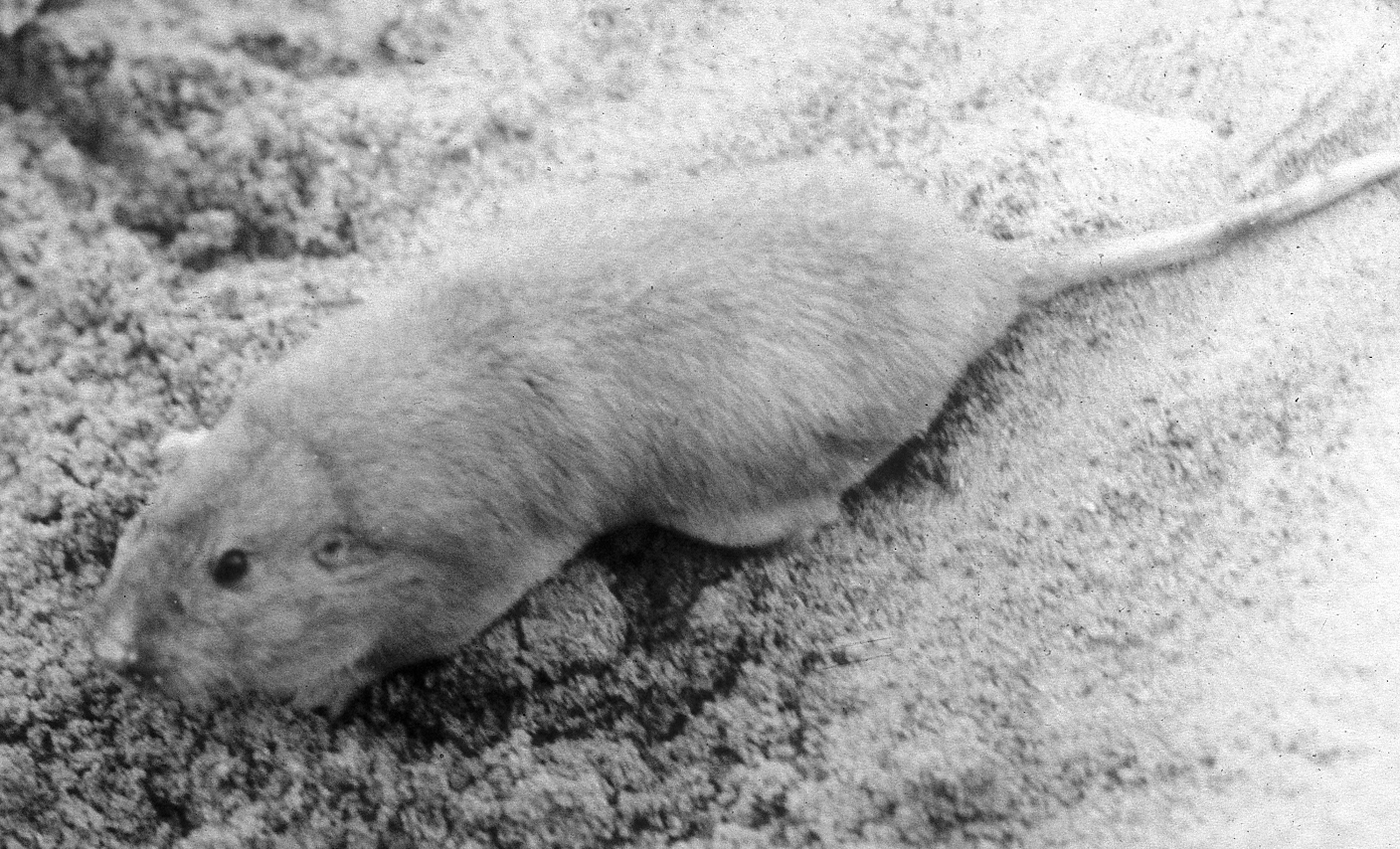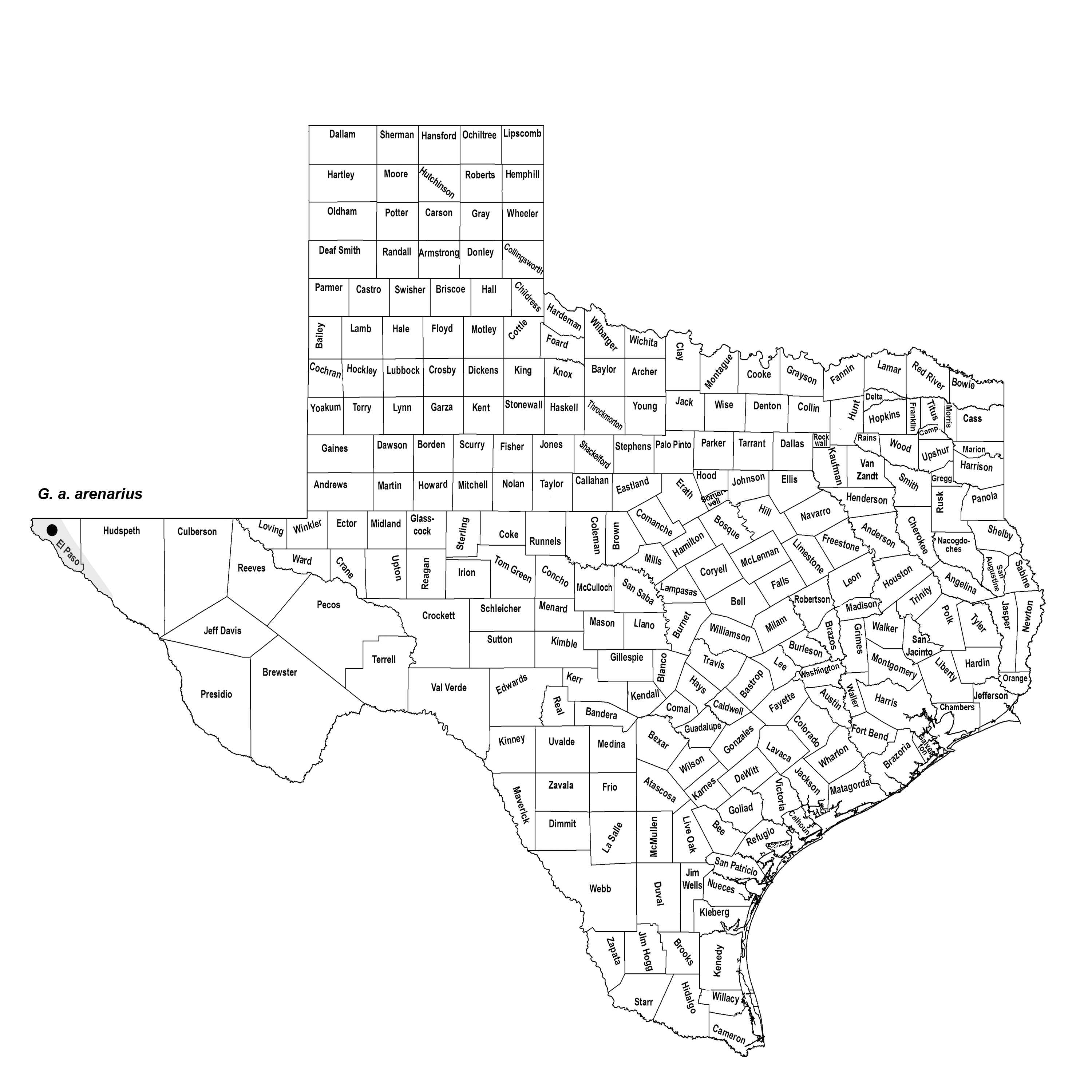DESERT POCKET GOPHER
Geomys arenarius Merriam 1895
Order Rodentia : Family Geomyidae
DESCRIPTION. A dull, pale-brown pocket gopher, with two longitudinal grooves on outer face of each incisor; feet and underparts white. Dental formula: I 1/1, C 0/0, Pm 1/1, M 3/3 × 2 = 20. External measurements averages: males, total length, 262 mm; tail, 79 mm; hind foot, 33 mm; females, 243-74-32 mm. Weight of males, 198–254 g; of females, 165–207 g. All species of Geomys in Texas are sexually dimorphic, with females being smaller than males.

DISTRIBUTION. Restricted in Texas to the far western Trans-Pecos, where it has been taken at several localities in the cottonwood–willow association along the Rio Grande in El Paso County.

SUBSPECIES. Geomys a. arenarius.
HABITS. Near El Paso these pocket gophers especially are common along irrigation ditches in the sandy river-bottom area. They seemingly cannot tolerate clay or gravelly soils, a characteristic common to all species of Geomys. Their mounds are large and conspicuous, and often one animal will throw up 20 to 30 of them in a relatively short time.
Their underground habits are not well known. Seth Benson (Museum of Vertebrate Zoology, University of California) reported finding flowers and cut stems of a composite (Baileya) in their burrows. Doubtless, these were being eaten. Cultivated alfalfa and roots and stems of native plants are their presumed food preferences.
Raymond Lee (University of Illinois) captured two pregnant females near El Paso on 28 June and one on 8 August. Numbers of embryos were six, four, and four, respectively. Young individuals have been captured in late June–August. These data indicate a prolonged breeding season and suggest that adult females bear more than one litter a year.
They may do considerable damage to agricultural crops. Otherwise, their burrowing activities are largely beneficial. Frank Blair observed that the bunchgrass Andropogon in New Mexico was intimately associated with the mounds of this pocket gopher. The grass appeared to grow more successfully on old gopher mounds than on the valley floor. The excrement of the gophers helped to fertilize the mounds.
POPULATION STATUS. Uncommon to common. Geomys arenarius is common in El Paso County as well as several localities where it has been obtained in New Mexico. However, given its extremely restricted population in Texas, this species is not overly abundant in the state.
CONSERVATION STATUS. The IUCN lists the desert pocket gopher as near threatened due its patchy distribution. It does not appear on the federal or state lists of concerned species. There are no known threats to its existence, but because of its restricted range in our state periodic monitoring is warranted.
REMARKS. Using karyotypic and electrophoretic analyses, in 1983 David Hafner (University of New Mexico) and Kenneth Geluso (University of Nebraska) found shared genetic characters in G. arenarius and G. knoxjonesi and considered the two taxa as subspecies. In 2006, DNA studies by Phil Sudman (Tarleton State University) and RDB showed that G. arenarius and G. knoxjonesi represent distinct species.
From The Mammals of Texas, Seventh Edition by David J. Schmidly and Robert D. Bradley, copyright © 1994, 2004, 2016. Courtesy of the University of Texas Press.
Natural Science Research Laboratory
-
Address
Museum of Texas Tech University, 3301 4th street, Lubbock, TX 79409 -
Phone
806.742.2486 -
Email
nsrl.museum@ttu.edu

